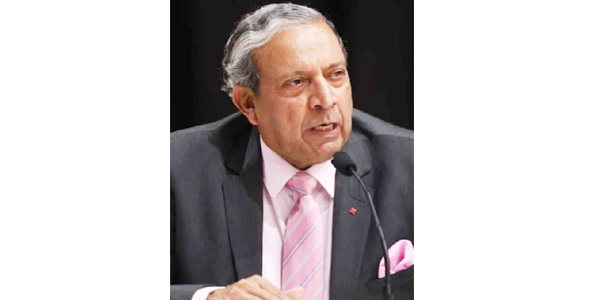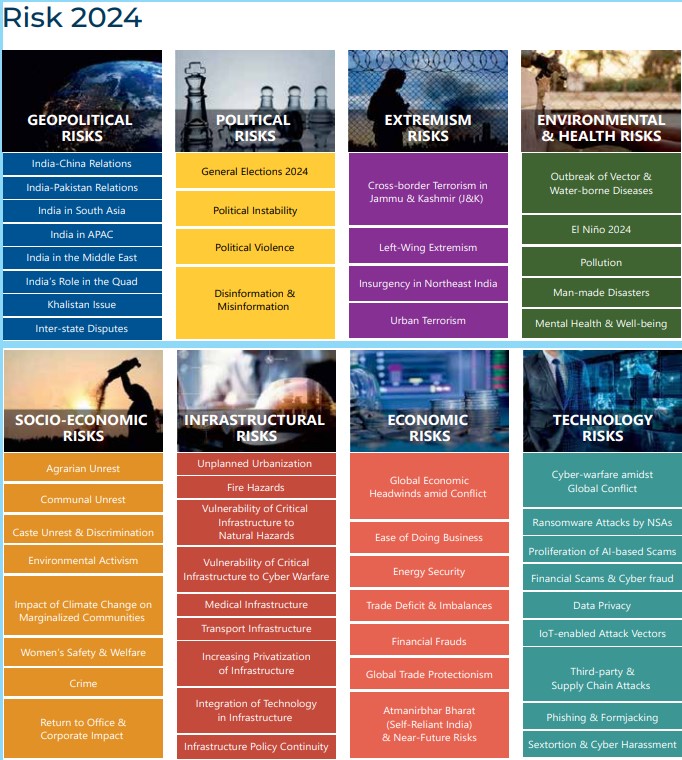The global security landscape in 2023 was characterized by the tumult as the world continued to witness geopolitical shifts while contending with internal developments – often resulting in an interwoven and complex nexus. In line with predictions, the engines of the global economy fired back up in the aftermath of the COVID-19 pandemic, with expectations of a new, more resilient framework driving it. However, what the world witnessed were multi-faceted ramifications that presaged a spiraling global crisis fueled by the escalation and perpetuation of regional conflicts, primarily those between Russia and Ukraine, and in Israel and Palestine. These evolving geopolitical dynamics have also impeded efforts towards global cooperation at a time when it is a sine qua non. A resurgence of carbon emissions, an unrelenting cost-of living crisis, and food and fuel shortages have exacerbated social divisions and caused unrest. Economic deceleration impacted countries across the world, often influencing political and policy decisions, while having a bearing on bilateral relations as well. Curtailed government spending, EXIM controls, and rate revisions came to characterize economic decisions across the world, forcing businesses to calibrate decision making to navigate through new realities.
India was not insulated from these global shocks, with its rising position in the global order placing it on a ringside seat to view, judge, and influence international developments. India’s G-20 Presidency in 2023 was testament to its pedigree as a growing international power, and the astute diplomacy it has practiced aided in weathering multiple difficult global challenges. Regardless, extant risks continued to pose governance challenges, while new risks developed in 2023 which will influence decision-making in the years to come.
On the geopolitical front, deteriorating relations with Canada dominated headlines after the latter accused the Indian government of involvement in the murder of Hardeep Singh Nijjar, a Canadian citizen allegedly involved in Khalistani activities. Over the course of a highly charged October characterised by assertions and censures, both the countries engaged in tit-for-tat moves that involved suspension of visa services and recalling of diplomats. Since then, however, the rhetoric employed by both governments has softened, and refocused on narratives of cooperation and friendship. Relations with China could best be described as a hostile peace – an absence of physical conflagrations must not be equated with a thawing of hostilities.
The continued construction of military and civilian infrastructure near the border in Arunachal Pradesh, the failure to gain meaningful ground on negotiations pertaining to de-deployment in the Ladakh theatre, and a virtual status quo in the overall situation meant that ties remain tense. Relations with Pakistan did not witness any significant deterioration or improvement, with internal political and economic instability taking the limelight. Continued cooperation in the domains of trade, commerce, and culture put India in a strong position in the Asia-Pacific region, which will be crucial in the year ahead as the situation in the South China Sea steadily heats up. India also kept up cooperation with its QUAD allies as both North Korea and China deployed an aggressive military posture in the larger region.

“The past year was marked by increased global strife and geopolitical uncertainty. In a ‘World Adrift,’ the brutal Hamas Israel war put further strain on an already fragile and fragmented world order. As a large number of countries align themselves against the US-Israel nexus in this conflict, the US influence may wane, giving the China-Russia axis more traction. India, which sits at the cross roads of its strategic partnership with US on one hand, and Russia on the other, would need to take some difficult geo-strategic decisions within the framework of its geographical compulsions and overarching national interest.
The early pointers to these shifting sands can be seen in the postponement of the QUAD summit planned for January 2024, and the apparent inability of President Biden to be the Chief Guest at India’s Republic Day Parade.
The high of successfully hosting the G20 summit by India in 2023 was soured by the accusation by Canada that Indian government-sponsored agents had plotted and killed a Canadian citizen on their soil. Followed closely on the heels of this diplomatic discord was the more damaging disclosure by USA of a failed but allegedly Indian Government supported rogue action to kill an American citizen. Both were avowed separatists with a strong anti-India stance. While these incidents are still unravelling, they have the potential to hamper or at least dent Indo-US strategic relations and if proved, will damage India’s diplomatic stock in the eyes of the Western world.
On the domestic front the upcoming general elections in the first half of 2024 are likely to be very polarizing and intense. Some degree of violence and conflict in some sensitive constituencies is possible. Elections are also planned for J&K, and would need deft handling as they would be under national and international spotlight. Elections in Pakistan and Bangladesh in 2024 would also have an impact in the region.
On the internal security front, the uptick in terrorist attacks in J&K is likely to continue and may increase in the buildup to elections, further exacerbating India-Pakistan relations. Continued unrest in Manipur and Naxal-dominated areas will stretch the security apparatus in 2024.
The overall economic outlook is robust, with satisfactory macro-economic indicators. However there is a continued need to tame inflation and create more job opportunities for the young and restive population of the country. Higher adoption of technology, continued digitalization and generative AI are all likely to give a major boost to the economy. The increasing pace of Apple products manufacturing in India, and possible entry of Foxconn, would also be a catalyst to the manufacturing sector.
Overall the year 2024 is likely to be stable, but challenging both domestically and on the geopolitical front. Economic growth which is reasonably insulated, will continue to make India the best performing major economy in 2024. The outcome of the watershed general elections would define India’s future for rest of the current decade.”
Lt Gen Sudhir Sharma, PVSM, AVSM, YSM, VSM, Chairman, MitKat
2024 will also be a critical year that may come to define and influence India’s progress for the next several years as the country will participate in the 18th Lok Sabha (Upper House) polls. The General Elections will be pivotal for multiple reasons, not least the formation of a multi-party opposition coalition titled ‘Indian National Developmental Inclusive Alliance’ (INDIA) consisting of nearly all national and regional opposition parties in the country. The ruling Bharatiya Janata Party (BJP) will be seeking to win a third consecutive term at the Centre, but issues such as the unabated violence in Manipur, increasing instances of communalism, the electoral losses in south India, and a unified Opposition may prove to be challenges. Regardless, the Opposition in India has also been beset by internal challenges including corruption, defections, disagreements, and a lack of convincing policy cohesion. Opposition losses in the crucial states of Rajasthan and Madhya Pradesh may also disrupt any gained momentum, but notwithstanding these factors, the 2024 elections would still mark the first time in a decade that the ruling dispensation will contend with a strong Opposition.

Security agencies in India were also on constant alert for new trends of extremism, with enduring threat vectors such as Islamic terrorism, Left-Wing Extremism (LWE), and insurgency in the northeast posing constant challenges. However, a defining aspect of terrorism trends in India was the resurgence of Khalistani separatism, both inside and outside the country. The months of February, March, and April were dominated by a multi-state manhunt for Sikh separatist leader Amritpal Singh and his aides following an attack on a police station in Punjab’s Ajnala. Despite his arrest, implicit manifestations of Khalistani threats continued to cause problems, and was also at the center of a major diplomatic fallout with Canada – an otherwise strong ally. Following a brief lull during the pandemic years of 2020 and 2021, cross-border terrorism in Jammu and Kashmir continued its upward curve in 2023, as security forces and non-native migrant workers were targeted. Conversely, barring sporadic escalations in the run-up to elections in Chhattisgarh, Left-Wing Extremism (LWE) or Naxalism continued its downward curve following constant anti-insurgency efforts.

Similarly, insurgency in northeast India was also largely contained, but the civil strife in Manipur has ignited apprehensions of the involvement of radical ethnic groups that may impede peace efforts. While there were no recorded attacks in India’s metro cities, multiple arrests by the National Investigation Agency (NIA) pointed towards a worrying trend of urban terrorism. The blast at Kalamassery in Ernakulam in October, assassination threats against the Prime Minister, and repeated bomb threats in cities such as Bengaluru, Delhi, and Mumbai hinted at growing sleeper cell activity, but also connoted alertness and proactivity on the part of security agencies.
Civil strife on the lines of ethnic divisions, religious differences, water-sharing conflicts, and agrarian issues, among many others, were widely reported across India in 2023. Among the most significant, violent, and enduring conflicts is the unrest in Manipur between the Kuki-Zo and Meitei tribal communities. What began in early May as a spontaneous escalation of simmering ethnic divisions has since spiraled into an insuppressible ethnic conflict with regional, national, and possibly international ramifications. The religious riots in Nuh in August exposed communal fault lines and ceased business in the proximate metro city of Gurugram for nearly a week, prompting misgivings of its vulnerability to such events, especially in the run-up to General Elections in 2024. 2023 also witnessed a fresh eruption of the inter-state dispute over Cauvery water-sharing between Karnataka and Tamil Nadu following an extended period of deficit rainfall.
The commercial hub of Bengaluru was shut down on two separate occasions, while other cities such as Mysuru also faced disruptions by activists opposing the release of water to lower riparian state Tamil Nadu, despite Court orders. Other issues that may gain momentum heading into General Elections are multi-faceted agrarian protests, reservation agitations by the Maratha community, government employees demanding the reinstating of the Old Pension Scheme, anti-privatisation protests, and political demonstrations over extant and circumstantial issues.
Among the most critical risks for civil society, governments, and businesses are to monitor and plan for in the years to come hinges on disruptions caused by extreme weather events. The increasing unpredictability and intensity of climatic disasters caused severe distress to daily lives and operations through 2023 in the form of landslides, floods, earthquakes, and subsequent disasters. Conventional methods of weather forecasting and risk mitigation that included historical averages of data have been proven ineffective in the face of climatic variability, forcing companies to realign estimations and adapt to newer technologies. Severe flooding in Gujarat, Tamil Nadu, Delhi, Maharashtra, Sikkim, and parts of northeast India, along with landslides in Uttarakhand, Himachal Pradesh, Jammu and Kashmir, and other hilly areas compounded these worries. While some parts of the country are historically and naturally vulnerable to these hazards, the increasing impact of flooding in urban centers has prompted serious discussions on sustainable urban development and the need to reimagine Indian cities.
Delhi and Chennai witnessed historic flooding in 2023, resulting in a near cessation of all business activities, damaging critical infrastructure, claiming lives, causing dis placements, and eventually eroding investor and business confidence. Seismic events in Delhi, Ladakh, Jammu and Kashmir, and proximate areas in the Himalayan range have refocused attention on business readiness to such events which cannot be predicted. 2023 was declared the hottest year in human history (on record), and with a Super El Niño predicted to last until at least May 2024, uneven weather conditions may continue to affect food production, trade patterns, hazard planning, and overall livelihood and well-being.
The year 2023 was also characterised by a protracted cycle of global economic deceleration, with multiple countries entering recession. India was not shielded from global economic shocks, and its increasing participation in international trade triggered apprehensions of a strong deceleration domestically. However, prudent monetary and fiscal policies, shaped with astute consideration of present and future conditions helped India navigate economic headwinds and boast a robust GDP growth output of 7.8 percent in the initial quarter of 2023, surpassing the likes of the United Kingdom to become the fifth largest economy in the world.
India’s strong economic performance was buoyed by initiatives like ‘Invest India’, ‘Vocal for Local’ and ‘Make in India’ while being underpinned by its export performance. However, economic whirlwinds in some key partner countries may yet affect export figures, while the extended Russia-Ukraine conflict, along with other geopolitical developments in the Asia-Pacific and the Middle East may hamstring progress in 2024, but multiple ratings agencies have predicted a strong 2024 for the country.
This economic performance enabled the government to increase spending and maintain a steady continuum in ongoing infrastructure projects. India’s eight key infrastructure sectors exhibited a growth of 12.1 percent on an annual basis in October after growing at 9.2 percent in September. For context, the relative figures for the same month in 2022 were 0.7 percent, indicating an evident focus on infrastructure growth. In 2024, infrastructure growth will hinge on key aspects including Planning and Governance, Public-Private-Partnerships (PPPs), Public Service Delivery, Urban Redevelopment, Sustainable Planning, and Smart Initiatives.


Finally, on the technology front, India continued to demonstrate its prowess in technological advancement and made a strong case to become the world’s leading focal point of innovation. India is among the largest exporters of Information Technology (IT) and Business Process Outsourcing (BPO) in the world and buoyed by tailwinds centered on structural policies and a large employable workforce with increasing skilled percentage participation, it could well become the driving force behind the world’s digital fabric.
The adoption and establishment of 5G infrastructure, transition to digital record-keeping, and advancements in data privacy regulations have fortified digital infrastructure in the country but have also conversely opened many critical segments up to new and sophisticated cyber threat vectors. State-sponsored cyber-attacks went up by 278 percent between 2021 and 2023 (September), and attacks by non-state actors have also skyrocketed. Distributed Denial of Service (DDoS) attacks, ransomware attacks, phishing, malware, and Zero-Day exploitations were commonly executed on critical infrastructure facilities including government databases, banking facilities, ports, and power generators. Besides this, the increasing use of Artificial Intelligence (AI) in nefarious activities such as deepfakes and fabricated videos will continue to pose major security challenges to individuals, governments, and businesses alike, as the boundary between ethics and innovation blurs.
Insider as well as external threats will feature high on risk priorities in 2024 as businesses seek to set up ramparts as a bulwark against cyber attackers.
Amidst this kaleidoscope of risks, it is of cardinal essence that businesses envision and chart a clear path forward that focuses on employee well-being, sustainability, compliance, and innovation. In a world that will continue to shift gears following two years of stasis, consequential events with global ramifications are very likely to occur and will be protracted in nature due to an increasingly divided world order. The impact of these events will be even more evident due to an accelerated effort to adjust to the ‘new normal’. As employees revert to physical workplaces and return to pre-pandemic models, the evident effects of national and global events will become perceptible and will need action.
Businesses in India must be cognisant of the country’s position in the world order, its outlook for the coming years, policy decisions in the making as well as those being implemented, the crests and troughs of the social tide, global and national threat vectors, and execute strategic business plans to remain ahead of the curve.
2024 has the potential to propel India to the highest echelons of the global order and businesses that are able to navigate through associated challenges and ride the wave of development have much to gain. While adversity will force businesses to rethink and restructure existing plans, it also gives them an opportunity to innovate, diversify, and transform into resilient entities.
*Views expressed in the article are solely of
MitKat Advisory Services Pvt. Ltd.
